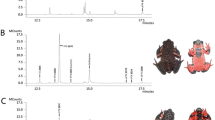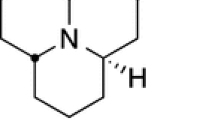Abstract
Alkaloid profiles for 81 individual mantellid frogs, Mantella baroni (Boulenger 1988) (N = 19), M. bernhardi (N = 51), and M. madagascariensis (Grandidier 1877) (N = 11), from six different populations from Madagascar were examined. Marked individual differences in alkaloid composition (number, type, and amount) were observed between different species and between populations of the same species. Disjunct populations of each of the three species differed significantly in alkaloid composition. Sympatric populations of M. baroni and M. madagascariensis also differed significantly in alkaloid composition. In M. bernhardi, differences in alkaloid composition were marginally associated with different sexes. A total of 111 alkaloids, including isomers, were detected in analysis of the individuals from the three species. The majority (47%) appear likely to be obtained from dietary mites, whereas many of the others (18%) are presumed to be from ants, and a few (4%) are from millipedes. Putative dietary sources for the remaining alkaloids are generally unknown, but beetles are probably the source of at least some of the tricyclic alkaloids (6%). In addition, alkaloid compositions from extracts of groups of individuals from five additional populations of M. baroni and from one population of M. bernhardi (Vences et al. 1994) and one population of M. cowanii (Boulenger 1882) were examined. An additional 50 alkaloids, including isomers, were detected in the combined samples, bringing the total number of alkaloids identified from these four species of mantellid frogs to 161. Alkaloid compositions in mantellid poison frogs are diverse and highly dependent on geographic location that appear to be largely determined by the nature and availability of alkaloid-containing prey items.






Similar content being viewed by others
Abbreviations
- ANOSIM:
-
analysis of similarity
- FAME:
-
fatty acid methyl ester
- GC–MS:
-
gas chromatography–mass spectrometry
- 3,5-I; 5,8-I:
-
disubstituted indolizidine
- 5,6,8-I:
-
trisubstituted indolizidine
- nMDS:
-
nonmetric multidimensional scaling
- PTX:
-
pumiliotoxin
- aPTX:
-
allopumiliotoxin
- hPTX:
-
homopumiliotoxin
- 3,5-P:
-
3,5-disubstituted pyrrolizidine
- 1,4-Q:
-
1,4-disubstituted quinolizidine
- SVL:
-
snout-to-vent length
- Spiro:
-
spiropyrrolizidine
- Tri:
-
tricyclic alkaloid
- ZCMV:
-
zoological collection Miguel Vences
References
Andreone, F., Cadle, J. E., Cox, N., Glaw, F., Nussbaum, R. A., Raxworthy, C. J., Stuart, S. N., Vallan, D., and Vences, M. 2005. Species review of amphibian extinction risks in Madagascar: conclusions from the global amphibian assessment. Cons. Biol. 19:1790–1802.
Chiari, Y., Vences, M., Vieites, D. R., Rabemananjara, F., Bora, P., Ramilijaona Ravoahangimalala, O., and Meyer, A. 2004. New evidence for parallel evolution of colour patterns in Malagasy poison frogs (Mantella). Mol. Ecol. 13: 3763–3774.
Chiari, Y., Andreone, F., Vences, M., and Meyer, A. 2005. Genetic variation of an endangered Malagasy frog, Mantella cowani, and its phylogeographic relationship to the widespread M. baroni. Cons. Genet. 6:1041–1047.
Clark, V. C., Raxworthy, C. J., Rakotomalala, V., Sierwald, P., and Fisher, B. L. 2005. Convergent evolution of chemical defense in poison frogs and arthropod prey between Madagascar and the Neotropics. Proc. Natl. Acad. Sci. U S A 102:11617–11622.
Clark, V. C., Rakotomalala, V., Ramilijaona, O., Abrell, L., and Fisher, B. L. 2006. Individual variation in alkaloid content of poison frogs of Madagascar (Mantella; Mantellidae). J. Chem. Ecol. 32–2219–2233.
Clarke, K. R. and Warwick, R. M. 2001. Change in marine communities: an approach to statistical analysis and interpretation, 2nd edition. PRIMER-E: Plymouth.
Daloze, D., Braekman, J. C., and Pasteels, J. M. 1995. Ladybug defense alkaloids: structural, chemotaxonomic, and biosynthetic aspects. Chemoecology 5/6:173–183.
Daly, J. W. 1998. Thirty years of discovering arthropod alkaloids in amphibian skin. J. Nat. Prod. 61:162–172.
Daly, J. W., Myers, C. W., and Whittaker, N. 1987. Further classification of skin alkaloids from Neotropical poison frogs (Dendrobatidae), with a general survey of toxic/noxious substances in the Amphibia. Toxicon 25:1023–1095.
Daly, J. W., Garraffo, H. M., Pannell, L. K., and Spande, T. F. 1990. Alkaloids from Australian frogs (Myobatrachidae): Pseudophyrnamines and pumiliotoxins. J. Nat. Prod. 53:407–421.
Daly, J. W., Secunda, S. Garraffo, H. M., Spande, T. F., Wisnieski, A. Nishihira, C., and Cover, J. F., JR. 1992. Variability in alkaloid profiles in Neotropical poison frogs (Dendrobatidae): genetic versus environmental determinants. Toxicon 30:887–898.
Daly, J. W., Garraffo, H. M., Spande, T. F., Jaramillo, C., and Rand, S. A. 1994a. Dietary source for skin alkaloids of poison frogs (Dendrobatidae)? J. Chem. Ecol. 20:943–955.
Daly, J. W., Secunda, S. I., Garraffo, H. M., Spande, T. F., Wisnieski, A., and Cover, J. F., Jr. 1994b. An uptake system for dietary alkaloids in poison frogs (Dendrobatidae). Toxicon 32:657–663.
Daly, J. W., Andriamaharavo, N. R., Andriantsiferana, M., and Myers, C. W. 1996. Madagascan poison frogs (Mantella) and their skin alkaloids. Amer. Mus. Novitates 3177:1–34.
Daly, J. W., Garraffo, H. M., Hall, G. S. E., and Cover, J. F., JR. 1997. Absence of skin alkaloids in captive-raised Madagascan mantelline frogs (Mantella) and sequestration of dietary alkaloids. Toxicon 35:1131–1135.
Daly, J. W., Garraffo, H. M., Jain, P., Spande, T. F., Snelling, R. R., Jaramillo, C., and Rand, S. A. 2000. Arthropod-frog connection: decahydroquinoline and pyrrolizidine alkaloids common to microsympatric myrmicine ants and dendrobatid frogs. J. Chem. Ecol. 26:73–85.
Daly, J. W., Kaneko, T., Wilham, J., Garraffo, H. M., Spande, T. F., Espinosa, A., and Donnelly, M. A. 2002. Bioactive alkaloids of frog skin: combinatorial bioprospecting reveals that pumiliotoxins have an arthropod source. Proc. Natl. Acad. Sci. U S A 99:13996–14001.
Daly, J. W., Spande, T. F., and Garraffo, H. M. 2005. Alkaloids from amphibian skin: a tabulation of over eight-hundred alkaloids. J. Nat. Prod. 68:1556–1575.
Daly, J. W., Wilham, J. M., Spande, T. F., Garraffo, H. M., Gil, R. R., Silva, G. L., and Vaira, M. 2007. Alkaloids in bufonid toads (Melanophryniscus): Temporal and geographic determinants for two Argentinian species. J. Chem. Ecol. 33:871–887.
Deslippe, R. J. and Guo Y. 2000. Venom alkaloids of fire ants in relation to worker size and age. Toxicon 38:223–232.
Garraffo, H. M., Caceres, J., Daly, J. W., and Spande, T. F. 1993a. Alkaloids in Madagascan frogs (Mantella): pumiliotoxins, indolizidines, quinolizidines, and pyrrolizidines. J. Nat. Prod. 56:1016–1038.
Garraffo, H. M., Spande, T. F., Daly, J. W., Baldessari, A., and Gros, E. G. 1993b. Alkaloids from bufonid toads (Melanophryniscus): decahydroquinolines, pumiliotoxins and homopumiliotoxins, indolizidines, pyrrolizidines, and quinolizidines. J. Nat. Prod. 56:357–373.
Glaw, F., and Vences, M. 2006. Phylogeny and genus-level classification of mantellid frogs. Org. Divers. Evol. 6:236–253.
Jones, T. H., Gorman, J. S. T., Snelling, R. R., Delabie, J. H. Q., Blum, M. S., Garraffo, H. M., Jain, P., Daly, J. W., and Spande, T. F. 1999. Further alkaloids common to ants and frogs: decahydroquinolines and a quinolizidine. J. Chem. Ecol. 25:1179–1193.
Mebs, D., Pogoda, W., Maneyro, R., and Kwet, A. 2005. Studies on the poisonous skin secretions of individual red bellied toads, Melanophryniscus montevidensis (Anura, Bufonidae), from Uruguay. Toxicon 46:641–650.
Michel, P., Rassat, A., Daly, J. W., and Spande, T. F. 2000. A stereospecific synthesis of (+/−)-5,8-disubstituted indolizidines and (+/−)-1,4-disubstituted quinolizidines found in poison frog skins. J. Org. Chem. 65:8908–8918.
Myers, C. W., and Daly, J. W. 1976. Preliminary evaluation of skin toxins and vocalizations in taxonomic and evolutionary studies of poison-dart frogs (Dendrobatidae). Bull. Am. Mus. Nat. Hist. 157:175–262.
Myers, C.W., Daly, J.W., Garraffo, H.M., Wisnieski, A., and Cover, J., Jr 1995. Discovery of the Costa Rican frog Dendrobates granuliferus in sympatry with Dendrobates pumilio, and comments on taxonomic use of skin alkaloids. Am. Mus. Novitates 3144:1–21.
Pintak, T. M., Vences, M., Glaw, F., and Böhme, W. 1998. Comparative chromosome morphology of Malagasy poison frogs (Amphibia: Ranidae: Mantella). Folia Zool. 47:197–204.
Saporito, R. A., Donnelly, M. A., Hoffman, R. L., Garraffo, H. M., and Daly, J. W. 2003. A siphonotid millipede (Rhinotus) as the source of spiropyrrolizidine oximes of dendrobatid frogs. J. Chem. Ecol. 29:2781–2786.
Saporito, R. A., Garraffo, H. M., Donnelly, M. A., Edwards, A. L., Longino, J. T., and Daly, J. W. 2004. Formicine ants: an arthropod source for the pumiliotoxin alkaloids of dendrobatid poison frogs. Proc. Natl. Acad. Sci. USA 101:8045–8050.
Saporito, R. A., Donnelly, M. A., Garraffo, H. M., Spande, T. F., and Daly, J. W. 2006. Geographic and seasonal variation in alkaloid-based chemical defenses of Dendrobates pumilio from Bocas del Toro, Panama. J. Chem. Ecol. 32:795–814.
Saporito, R. A., Donnelly, M. A., Norton, R. A., Garraffo, H. M., Spande, T. F., and Daly, J. W. 2007a. Oribatid mites as a major dietary source for alkaloids in poison frogs. Proc. Natl. Acad. Sci. U S A 104:8885–8890.
Saporito, R. A., Donnelly, M. A., Jain, P., Garraffo, H. M., Spande, T. F., and Daly, J. W. 2007b. Spatial and temporal patterns of alkaloid variation in the poison frog Oophaga pumilio in Costa Rica and Panama over 30 years. Toxicon 50: 757–778.
Schaefer, H. C., Vences, M., and Veith, M. 2002. Molecular phylogeny of Malagasy poison frogs, genus Mantella (Anura: Mantellidae): homoplastic evolution of colour pattern in aposematic amphibians. Org. Divers. Evol. 2:97–105.
Smith, B. P., Tyler, M. J., Kaneko, T., Garraffo, H. M., Spande, T. F., and Daly, J. W. 2002. Evidence of biosynthesis of pseudophrynamine alkaloids by an Australian myobatrachid frog (Pseudophryne) and for sequestration of dietary pumiliotoxins. J. Nat. Prod. 65:439–447.
Takada, W., Sakata, T., Shimano, S., Enami, Y., Mori, N., Nishida, R., and Kuwahara, Y. 2005. Scheloribatid mites as the source of pumiliotoxins in dendrobatid frogs. J. Chem. Ecol. 31:2403–2415.
Torres, J.A., Zottig, V. E., Co, J. E., Jones, T. H., and Snelling, R. R. 2001. Caste specific alkaloid chemistry of Solenopsis maboya and S. torresi (Hymenoptera: Formicidae). Sociobiology 37:579–584.
Vences, M., and Kniel, C. 1998. Mikrophage und myrmecophage Ernährungsspezialisierung bei madagassischen Giftröschen der Gattung Mantella. Salamandra 34:245–254.
Vences, M., Glaw, F., and Böhme, W. 1998. Evolutionary correlates of microphagy in alkaloid-containing frogs (Amphibia: Anura). Zool. Anz. 236:217–230.
Vences, M., Glaw, F., and Böhme, W. 1999. A review of the genus Mantella (Anura, Ranidae, Mantellinae): taxonomy, distribution and conservation of Malagasy poison frogs. Alytes 17:3–72.
Vences, M., Chiari, Y., Raharivololoniaina, L., and Meyer, A. 2004. High mitochondrial diversity within and among populations of Malagasy poison frogs. Mol. Phyl. Evol. 30:295–307.
Vieites, D. R., Chiari, Y., Vences, M., Andreone, F., Rabemananjara, F., Bora, P., Nieto-román, S., and Meyer, A. 2006. Mitochondrial evidence for distinct phylogeographic units in the endangered Malagasy poison frog Mantella bernhardi. Mol. Ecol. 15:1617–1625.
Acknowledgments
We are grateful to numerous students, guides, and colleagues for their assistance during fieldwork, in particular to Parfait Bora, Euan Edwards, Falitiana Rabemananjara, Emile Rajeriarison, Theo Rajaofiarison, Edouard Randriamitso, Tokihery Razafindrabe, and Cindy Woodhead. Olga Ramilijaona and Noromalala Raminosoa provided valuable assistance. We are indebted to MICET/ICTE for logistical support. The Tsinjoarivo samples were kindly provided by Franco Andreone in January of 2003. The work was carried out in the framework of collaboration accords of the authors’ institutions with the Département de Biologie Animale, Université d’Antananarivo and the Association Nationale pour la Gestion des Aires Protegées, ANGAP. We are grateful to the Malagasy authorities, in particular the Ministère de l’Environnement, des Eaux et Forêts and the ANGAP, for research and export permits. Fieldwork was supported by the Volkswagen Foundation and the BIOPAT foundation. One of the authors (R.A.S.) was the recipient of an NIH Courtesy Associates appointment. The support of the NIH undergraduate Scholarship Program for author L.-A.G. is gratefully acknowledged. D.R.V. was supported by the NSF AmphibiaTree Grant EF-0334939. The research at NIH was supported by intramural funds of the National Institute of Diabetes and Digestive and Kidney Diseases.
Author information
Authors and Affiliations
Corresponding authors
Electronic Supplementary Material
Below is the link to the Electronic supplementary material.
ESM 1
Supplementary Information (DOC 121 kb).
Rights and permissions
About this article
Cite this article
Daly, J.W., Garraffo, H.M., Spande, T.F. et al. Individual and Geographic Variation of Skin Alkaloids in Three Species of Madagascan Poison Frogs (Mantella). J Chem Ecol 34, 252–279 (2008). https://doi.org/10.1007/s10886-007-9396-9
Received:
Revised:
Accepted:
Published:
Issue Date:
DOI: https://doi.org/10.1007/s10886-007-9396-9




